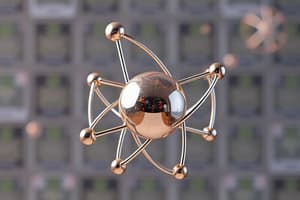Podcast
Questions and Answers
Which of the following statements accurately describes the arrangement and behavior of particles in a solid?
Which of the following statements accurately describes the arrangement and behavior of particles in a solid?
- Particles slide past each other with moderate attraction.
- Particles vibrate in fixed positions with strong attraction. (correct)
- Particles are randomly moving in any direction.
- Particles move freely and are far apart.
Which of the following represents the classification of matter that possesses a definite volume but lacks a definite shape?
Which of the following represents the classification of matter that possesses a definite volume but lacks a definite shape?
- Liquid (correct)
- Solid
- Gas
- Plasma
What happens to the kinetic energy of particles in a substance as the temperature decreases?
What happens to the kinetic energy of particles in a substance as the temperature decreases?
- Kinetic energy increases
- Kinetic energy decreases (correct)
- Kinetic energy remains the same
- Kinetic energy fluctuates randomly
Which subatomic particle determines the identity of an atom?
Which subatomic particle determines the identity of an atom?
During the process of deposition, which phase transition occurs?
During the process of deposition, which phase transition occurs?
What is the defining characteristic of elements within the same group on the periodic table?
What is the defining characteristic of elements within the same group on the periodic table?
How are elements arranged within a period on the modern periodic table?
How are elements arranged within a period on the modern periodic table?
According to Rutherford's model, where is most of the mass of an atom concentrated?
According to Rutherford's model, where is most of the mass of an atom concentrated?
What charge will an atom have if it gains two electrons?
What charge will an atom have if it gains two electrons?
Which of the following statements best describes what generally happens to atomic size as you move from left to right across a period on the periodic table?
Which of the following statements best describes what generally happens to atomic size as you move from left to right across a period on the periodic table?
Flashcards
Periodic Table
Periodic Table
An arrangement of elements by atomic number and properties.
Groups in the Periodic Table
Groups in the Periodic Table
Vertical columns of elements with similar chemical properties.
Reactivity Trend
Reactivity Trend
Reactivity generally decreases from left to right across a period.
Plum Pudding Model
Plum Pudding Model
Signup and view all the flashcards
Ion Formation
Ion Formation
Signup and view all the flashcards
Matter
Matter
Signup and view all the flashcards
Solid
Solid
Signup and view all the flashcards
Gas
Gas
Signup and view all the flashcards
Atomic number
Atomic number
Signup and view all the flashcards
Freezing
Freezing
Signup and view all the flashcards
Study Notes
Periodic Table Organization
- Elements are arranged in the periodic table based on increasing atomic number.
- As you move from left to right, the atomic size generally decreases.
- As you move from left to right, the reactivity generally decreases.
- Elements in the same group have similar properties.
- Metals are located on the left side of the table; they are good conductors of electricity.
- Group 1 is called Alkali Metals.
- The periodic table is organized vertically by groups and horizontally by periods.
Atomic Structure
- The periodic table is organized based on atomic structure and properties.
- Atoms are composed of smaller particles: protons, neutrons, and electrons.
- Protons are positively charged, neutrons are neutral, and electrons are negatively charged.
- The nucleus of an atom contains protons and neutrons.
- Electrons orbit the nucleus.
- The number of protons defines the element.
Plum Pudding Model
- Proposed by J.J. Thomson.
- Atoms are a sphere of positive charge with electrons embedded in it, like plums in a pudding.
Rutherford's Model
- Proposed by Ernest Rutherford.
- Atoms are mostly empty space.
- Almost all of the mass is concentrated in the positively charged nucleus.
- Electrons orbit the nucleus.
Isotopes and Atomic Number/Weight
- Atoms of the same element can have different numbers of neutrons.
- These are called isotopes.
- The atomic number is the number of protons in an atom.
- The atomic weight is the average mass of all the isotopes of an element.
Studying That Suits You
Use AI to generate personalized quizzes and flashcards to suit your learning preferences.




